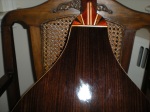Mandocello Redux
One way to tell you’re approaching geezerhood is when you start to tell stories that begin,” About 25 years ago…” The other is when your digital pictures come out badly, and you have to apologize for the quality.
Sorry about the pictures, I’ll get a kid to take some new ones.
About 25 years ago, the small carpentry firm I worked for got a job installing some very large crown molding in an apartment in one of the fine old buildings on Rittenhouse Square in Philadelphia. The client was the mother of one of our regular clients ,and also had a son who was a very well known TV game show producer and personality (Gong!) As it turned out, she was a bit of a perfectionist.
This crown was unwieldy, probably 12″ overall from bottom to top, made of molded foam encased in some coating that when painted would appear to be the original elaborate plaster molding that was in some other parts of the apartment. At $30. a running ft, 1985 prices, it needed to be cut and handled and put up very carefully. The room was large with only a couple irregularities, but it was still necessary for me to build a miter box that I could use with a hand saw, this being in the days before large sliding miter saws that one could use now.
Everything went fine, except that there was a pair of windows on the wall overlooking the square, the top molding of which came within a foot of the 12 foot ceilings before the molding, and so now were about 4 inches from the bottom of the crown. The problem was, the gap was 3 1/2 inches on one end, and 4 1/4 on the other end 7 feet away ( I think you’re getting the picture that this was no ordinary apartment.) It was an old building, and either the ceiling or the windows had settled. It didn’t matter which, because there was nothing that could be done,. There are tricks you can do with crown, that I won’t go into here, but this stuff was so inflexible, and there was no obvious hump in the ceiling that could be scribed. We crossed our fingers and hoped that the overall magnificence of the job we did would cause her to overlook a minor flaw that would be even less noticable once it was painted to match the ceiling.
She walked in from her shopping trip, eyes immediately going to the windows, and said, “Well it’s crooked!” We patiently explained about the age of the building, the nature of the product, the paint ,etc, to which she replied, “Well, if that’s how it’s going to look, I don’t want it. Just take it down.”
I put in a call to my boss, who rarely came out to any job, because I knew he was not going to be happy about the $3,000 in materials that no one would ever use, even if we could salvage it, to say nothing of the cost of a couple days putting it up. We stood around staring at the gap, my boss, myself, and Frank, the older plasterer who worked with us. He thought maybe he could reason with her, but Frank assured him that she was adamant. Finally I said,” You know, I can fix this, but you’re not going to like it.”
There were 3 legs of vertical trim on the windows, and I explained that I could cut 3/4″ off the top of one end, 3/8″ off the middle, leave the other one, and lower the top molding to be parallel with the crown. OK, it was a radical approach. The boss looked around the room, measuring I’m sure, and multiplying by $30, and 15 seconds later said “Do it.” Frank, who was old school,thought it was crazy, but I pointed out the large reveals at the top, and the dark finish om the wood. He just shook his head.
So that’s what I did. I’m not proud of it, except that it worked. Frank was still there after I had left, and told me she walked in, looked at it, and said, “Well, that’s better! How did he fix it?” Frank said, “I’m not saying anything.” And then she provided the punchline, that I’ve used a hundred times in the years since.
“Well, I just don’t know why he didn’t do it right the first time.”
THE MANDOCELLO
The first mandocello I built looked great and sounded wonderful. I thought I had made the neck too narrow at the top, but it was playable. But the neck developed other issues. It’s amazing the amount of force that is required to tune one of these up with the large gauge strings used, more or less 300 lbs., enough to cause a slight bow in the neck, and since I had used a non-adjustable truss rod, there was nothing that could be done.
This one, I made a wider neck, also laminated, but this time reinforced with carbon fiber rods AND and a two way adjustable Hot Rod truss from StewMac. I did an f-hole top this time, to suggest a traditional cello, and again did a little marquetry on the back. This detail has another purpose, one that should never need to be served, but having applied it with hide glue, it could be heated up and removed to access the neck without taking the top or the back off.
I think it came out pretty well. I just don’t know why I didn’t do it right the first time.
Sitka spruce top, rosewood back and sides, padauk and lacewood reinforced neck, marquetry of bloodwood, ebony, holly and maple.
Here are some sound files, recorded by Mike Plunkett:
02 Living in the Country (Bahaman Folk Song)







